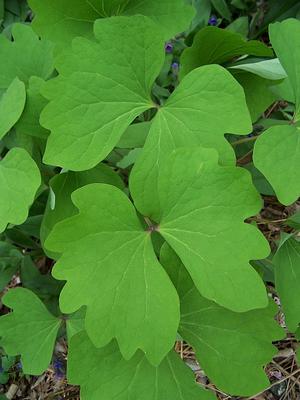View All Plants :: View All QUACKIN' GRASS INTRODUCTIONS :: View All SHADE PERENNIALS

6 or more "serrations" on a single leaf (12 or more per pair) are the marker for 'Leslie's Chainsaw Massacre'
Jeffersonia diphylla 'Leslie's Chainsaw Massacre'
Twinleaf
Plant Type:
QUACKIN' GRASS INTRODUCTIONSJeffersonia diphylla ‘Leslie’s Chainsaw Massacre’ – This cultivar sports serrated edges on the twin leaves. Six or more "serrations" on a single leaf (12 or more per pair) are the marker for 'Leslie's Chainsaw Massacre'. This interesting variant is named for the virtually perpetual president of the Connecticut chapter of the Hardy Plant Society, Leslie Shields. When I informed Leslie that I had named a plant for her she spontaneously exclaimed, “I’m almost afraid to ask!” You see, Leslie knows full well my penchant for dark gritty names. When I pointed to the plant and told her its moniker she was brought to tears – I’ll never know if it is because she was deeply touched or just plain mortified! The young foliage doesn’t show the demonstrable serrations seen on the mature leaves. You must be patient and the interest will develop. Only one will be available per customer. Be certain to check availability numbers before ordering. Order early as we are likely to only ever have a few available annually.
For a more in depth discussion please see Jeffersonia diphylla in our HERALD section.
Characteristics and Attributes for Jeffersonia diphylla 'Leslie's Chainsaw Massacre'
Season of Interest (Flowering)
- Spring
Season of Interest (Foliage)
- Summer / Autumn
Autumn Interest
- Fruit / Berries / Seed Heads
Nature Attraction
- Deer Resistant
Light
- Morning Sun / Afternoon Shade
- Dappled Shade
- Shade
Attributes
- Woodland
- Specimen
- Natural Garden
- Rock Garden
Growth Rate in the Garden
- Slow
Soil
- Fertile
- Woodland
- Draining
Origins
- Quackin' Grass Nursery
Propagated By
- Division
Genus Overview: Jeffersonia
Common Name: Twinleaf
Twinleaf. Each wiry stem supports a pair of mirrored kidney-shaped leaves. The ephemeral flowers in April-May are cupped daisies in a light pink to white tint. They are followed by pear-shaped seed pods that suddenly pop open spewing forth the small seed. The dried seed pods look like little stylized Jack-in-the-pulpits and can be used in small autumn/winter dried arrangements. Though not found in New England it is hardy for us in the southern reaches of the Northeast. Named for Thomas Jefferson, this most handsome member of the Berberidaceae looks great all season in the woodland garden. Site them in draining soil in dappled to open shade conditions. The following are offered by division. We’re likely to only have but a few available annually as they resent disturbance and are then very slow to size up. Be certain to check availability numbers before ordering. Only one per customer and please order early.